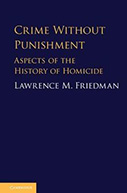Crime Without Punishment: Aspects Of The History Of Homicide

Author: Lawrence M. Friedman
Publisher: Cambridge, UK: Cambridge University Press, 2018. 155p.
Reviewer: Guyora Binder | September 2020
Weber famously identified the state with a monopoly on the use of legitimate force. In this view, the rules defining criminal homicide also delimit sovereignty itself. This accounts for some of the drama and interest in homicide. Both homicide and the legal system’s response to it may be experienced as a kind of political theater. Unauthorized homicide is not only a tragedy, but a challenge to law’s authority. And—as Hay and Foucault demonstrated—authorized homicide may be staged as a vindication of the law’s majesty.
That homicide is not necessarily illegitimate makes every homicide ambiguous and fraught. Whether subversive or restorative of law’s authority, homicide can imply a claim to rule. This claim, moreover, may be ambiguous. An act of violence that some interpret as subversive may be interpreted by others as a reassertion of the legitimate legal order in the face of corruption. Indeed, most revolutionary movements make such restorative claims, as the term’s circular metaphor suggests.
Accordingly, we might expect homicide to be particularly polysemous in a polity with revolutionary origins. The more so, in what Aziz Rana (The Two Faces of American Freedom (2014)) has called a “settler society” with a legacy of private government and violent self-help. Indeed, the United States is famously violent, with homicide rates persistently exceeding those of other prosperous democracies. According to Randolph Roth (American Homicide (2009)), these rates rose in the West after the Mexican American War, and in the South and, to a lesser extent in the Midwest, after the Civil War. In war zones, civilian authority has little effective control, while much of the male population becomes accustomed to the authorized exercise of force. Moreover, civil war and conquest both leave a legacy of a divided population. Roth’s comparative research shows that across many times and places, homicide rates tend to track observed levels of disaffection from government and the legal system, and levels of intergroup conflict. These relationships accord with our intuition that both homicide, and the legal response to it, are sometimes forms of political contestation.
This is the fascinating territory the celebrated legal historian Lawrence Friedman explores in Crime Without Punishment: Aspects of the History of Homicide. Friedman studies five types of homicide that, for a period of time in American history, were proscribed by law as serious crimes and yet were so tolerated by social norms that they often went unpunished. His data points are vigilante justice in the West; lynching, primarily in the South; killing romantic rivals pursuant to an “unwritten law”; infanticide; and mercy-killing (there is also a very brief chapter on life-boat situations). Most of these episodes took place in the late nineteenth and early twentieth centuries (although Friedman’s interest in mercy killing continues up to the present), and Friedman’s narratives of these episodes are informed by research in the databases of four major newspapers, as well as the work of prior historians.
Crime Without Punishment packs a host of interesting vignettes into its 140 pages of text and notes, and draws some thematic connections, but largely leaves the reader free to interpret this rich material. Nevertheless, the title and the stated principle of selection imply a frame. Homicide law on the books has a straightforward content: subject to recognized justifications and excuses, all intentional killing is murder. But in action, this law is defeated by social norms, which permit killings of certain persons for certain reasons. Yet there are always at least two ways of accounting for normative conflict in a legal setting. Friedman’s framing as law vs. social norms is reminiscent of one strand of legal realism. According to this view, legal outcomes are determined not by law, but by something extrinsic—social status, or norms or needs. Yet another strand of legal realism saw conflicting claims arising in the competitive struggle for life as articulate within law. From this perspective, impunity may reveal not popular nullification of law, but indeterminacy and discretionary judgment within law. To choose between these frames, we would need to know a lot of jurisdictionally specific information about law and legal procedure. However, Friedman is primarily interested in understanding the social norms and so tells us little about the law. Yet even for this purpose, his framing of the material as legal liability defeated by social norms of impunity is somewhat procrustean; social judgments of harm, culpability, and differential status may be reflected in grading and mitigation of liability as well as in decisions to justify, excuse, or acquit on grounds of failure of proof. It is tempting to view divergence between law and behavior as evidence of a sticky social norm, but that presumes that law can be observed independent of its application in behavior.
Friedman’s discussion of vigilante justice builds on a study by Richard Maxwell Brown, identifying the phenomenon as concentrated in the west and in the second half of the nineteenth century. Friedman acknowledges that the tradition of irregular law enforcement dates back to colonial times, but tells us little about these origins. Indeed, one might start the story even earlier, with the institutions of jury presentment and hue and cry in medieval England. Before the development of police forces, citizen participation was a familiar element of law enforcement. Vigilance committees could therefore root their claims to legitimacy in tradition. Moreover, the revolutionary experience left a legacy of suspicion of law enforcement officers. Vigilance committees also could draw on traditions of settler collective defense, citizen posses, and slave patrols in the South. Friedman notes that these committees were often led by business elites, who criticized official law enforcement as gangsters or as agents of corrupt political bosses. This reader wanted to hear more about the relationship between vigilante action and particular social and economic conflicts, such as labor disputes.
For example, in 1916 in Bisbee, Arizona, a mining company organized a vigilance committee of thousands to round up and forcibly deport over a thousand miners during a strike organized by the I.W.W. There were only a few homicides, but the incident is particularly significant because it led to a trial in which the vigilantes successfully presented a necessity defense, arguing that they suspected the “Wobblies” of wartime subversion and plotting to blow up the mines, and that local law enforcement lacked the capacity to deal with the crisis. After receiving a lengthy and learned instruction on this defense, the jury acquitted. Necessity as a justification for homicide was supported by American precedents concerning maritime emergencies, such as the famous Holmes case, endorsing cannibalism and human jettison in life-boat situations as long as danger was imminent and fair and democratic procedures were employed. Friedman briefly discusses Holmes, but does not develop its doctrinal connection to vigilante actions like the Bisbee deportation. The blurring of boundaries between state and citizen in the settler tradition enabled vigilantes to present themselves as legitimate agents of law.
Friedman emphasizes that Southern lynching and Western vigilante justice were related phenomena. Although rejected by the common law, slavery was a form of private governance authorized by customary law. Indeed, perhaps we should view slavery as the original “crime without punishment” in American history. Certainly a settler tradition of organized violence against indigenous and slave populations can account for a persistent attitude that some persons are unprotected by law. But it also helps account for the legitimation of private violence as law enforcement. In American Slavery, American Freedom (2003), Edmund Morgan showed how ownership of human property afforded Virginia planters the material independence required for republican self-government. Yet slave patrols permitted unpropertied white men to participate in that government as its agents. Slave patrols presumably provided models for the Klan and for white supremacist mobs. Friedman draws illuminating connections between lynch mobs and “race riots,” murderous rampages against African Americans by armed whites. He also links the Western vigilante critique of law enforcement, with the Southern white supremacist critique of reconstruction governments.
Friedman’s chapter on “the unwritten law” agrees with other accounts showing that jealous husbands were lauded and acquitted for killing their rivals, not their adulterous wives. Yet it offers the fresh revelation that wives also benefited from an “unwritten law” excusing them for killing not only their rivals, but also abusive husbands. Journalists called this norm “unwritten,” but was it entirely extralegal? That the common law mitigated killings of rivals by jealous husbands as “provoked” showed that the law endorsed the motive for these killings, if not the act. On the law’s assumption that the cuckolded husband is rightly enraged by a legal wrong, jury findings of temporary insanity may have been less cynical than Friedman takes them to be.
Friedman’s chapter on infanticide reports expressions of belief that infanticide was widespread in nineteenth century America. He skillfully marshals indirect evidence in support of this suspicion: the desperate economic circumstances and social shame of single mothers; the great dangers of abortion; and the appearance of “baby farms” where, for a modest fee, young mothers could abandon their newborns, who would somehow discreetly disappear. Friedman documents a social norm of sympathy for the plight of unwed mothers from newspaper discussions, and explains a paucity of murder convictions in light of this norm. But he sometimes overstates the tension between law and social norms: “Technically, of course, killing a newborn was murder. … In England, this should have meant the death penalty. But these women were virtually never sentenced to death. Juries acquitted them or convicted them of a minor crime.” The “minor crime” was a statutory offense of concealing the body of a newborn, which seemed designed for the very situations to which juries applied it. Conversely, killing was murder only if intentional, and it would have been unusual in the nineteenth century to treat passive neglect as killing. Did the evidence always support murder in these cases? It was not easily proven that the infant had been born alive and that the mother had caused death intentionally. Of course social norms sometimes induce juries to convict on thin evidence, so it is fair to see social norms as also operative when juries are selectively fastidious about proof. Yet that does not mean that social norms are thereby defeating law.
Friedman’s juxtaposition of infanticide with mercy killing reveals disturbing connections, as some of the perpetrators in his early twentieth century cases are parents who killed dependent children with disabilities and burdensome care needs. He introduces the early twentieth century eugenics movement and discusses choices by doctors and parents to allow death through omission to treat disabled newborns. He then discusses what he suspects is the common practice of “lethal dosing”—prescribing fatal doses of pain medication for terminally ill patients. He points to a 1988 AMA opinion approving this practice, albeit in the oblique language of risk. Surveys revealed only a small minority of doctors who admitted to doing it, but a substantial minority said they would it if it were legal. The high cost of end of life care and a professional ethos of triaging scarce resources no doubt combine with empathy for suffering patients in encouraging this attitude among doctors. Physicians are protected from legal risk by professional authority and have the technical knowledge to prudently structure euthanasia as omission, or as a side-effect of palliation. By contrast, distraught relatives who dispatch languishing patients with guns or hammers are more likely to face prosecution. Yet Friedman shows that even these often endure little punishment.
There is a great deal about American attitudes about race, gender, religion, disability and dependency revealed by Friedman’s brisk recounting of these episodes. But there is more we may yet learn about American attitudes about governmental authority, culpability and causal responsibility from further examination of the operation of law in homicide cases.
Guyora Binder, SUNY Distinguished Professor; Hodgson Russ Faculty Scholar; Vice Dean for Research and Faculty Development


